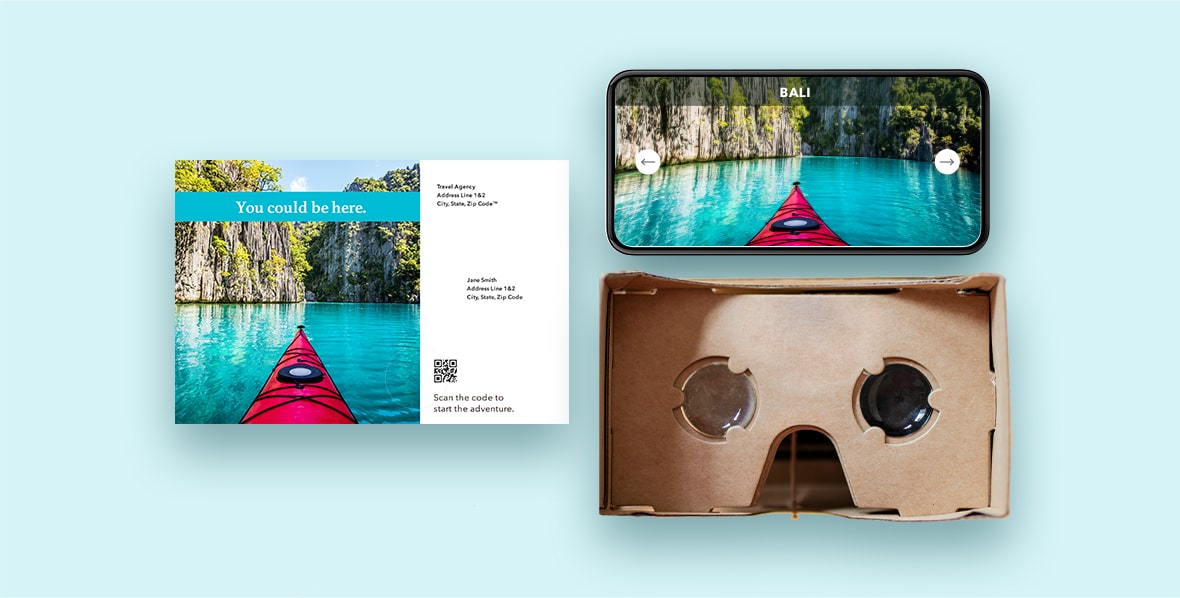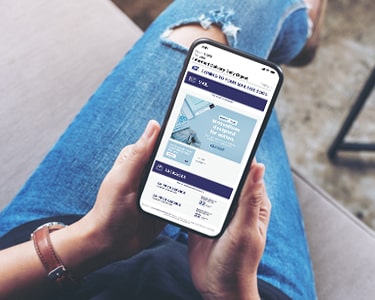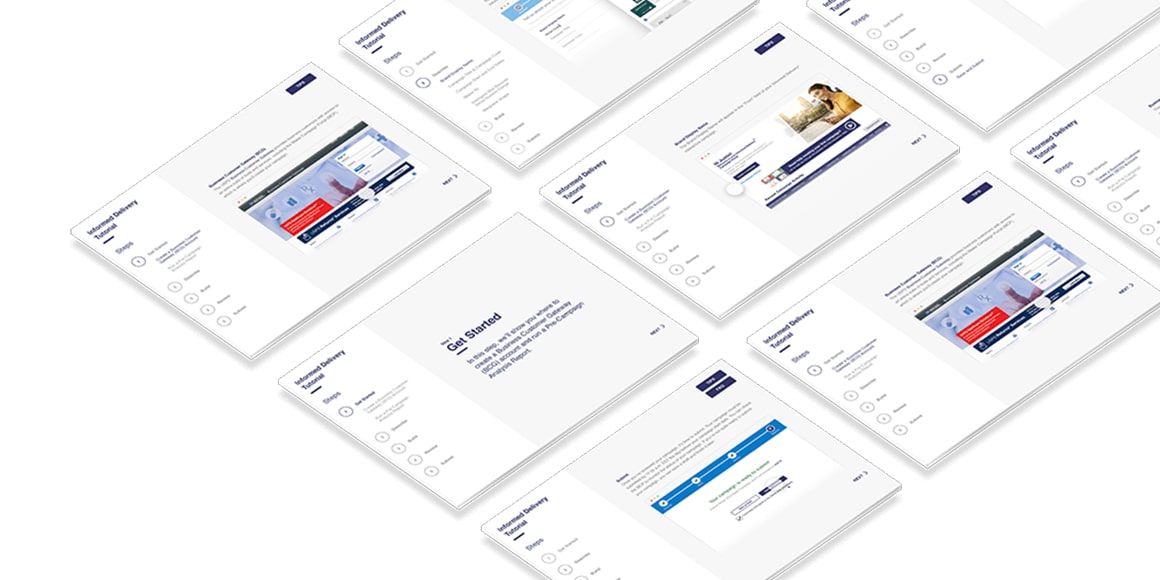
The marketing world was once dominated by all things digital. Whether companies were focusing on click-through rates or follower counts, the majority of marketing efforts were dedicated to enhancing a brand’s digital presence.
Today, a seamless omnichannel strategy reigns supreme. To drive consumer action, well-rounded marketing campaigns coordinate a range of different media—from print materials to social channels to immersive sensory experiences.
Direct mail (DM), in particular, continues to be a major profit driver in its own right, resulting in response rates of 9% for house lists and 5% for prospect lists.[1] Integrating sophisticated interactive technologies into direct mail opens up even more possibilities—for example, including QR Codes® in print media to lead customers to your digital channels.[2]
Here, we’ll discuss eight strategies—some already very popular, some on the rise—that will help capture customers’ attention and keep your brand ahead of the curve. As you read through, consider your company’s key goals. Are you looking to create mail that engages or informs—or both? Do you want to launch a new product or convert customers? Are you hoping to drive traffic to a newly launched digital channel?
Whatever your specific aim, we’ve gathered the facts so you can begin zeroing in on a more profitable future.
Bring Your Campaigns to Life
Read through the seven technologies below to see how you can start incorporating them into your marketing efforts.
Quick Response (QR) Codes
These easily scannable black-and-white grids of squares are an obvious sign that printed material is a gateway to rich digital content.
When a consumer scans a QR Code with a mobile device, the smartphone or tablet can automatically open a website, launch a prefilled email or text message, dial a phone number, download contact information, and more. Research shows that more than 1 billion smartphone users worldwide will use QR Codes by 2022.[3]
- How It’s Made: A QR Code generator creates a unique code that contains the data necessary to guide users to branded content. Various generators are available to marketers, offered either as software or online tools.
- User Experience: Users can scan QR Codes quickly and easily with a smartphone or tablet camera. Scanning a QR Code can activate nearly any experience that a mobile device allows. For example, you may wish to lead people to a coupon or discount, an entertaining video or further product information.
- Measuring Success: Integrated QR Code services can measure how often each code is scanned, provide valuable click-through information and determine the dominant language on the phone or tablet used to scan. Time, location and total number of scans can be tracked as well. Data can also be provided on the best-performing QR Codes and even the type of operating system (OS) people are using to scan them.


Personalized URLs (PURLs)
PURLs are created for individual customers, leading them to unique landing pages or microsites. By including these URLs on direct mailpieces, you can encourage people to access a personalized offer—such as an exclusive discount—or digital experience.
Not only does this help make customers feel special, but it also seamlessly connects your digital and print marketing efforts while allowing for easy tracking of individual online activity.
- How It’s Made: Companies can choose to work with a service provider, which will create a full campaign, with all data and pages maintained on their own server. If you’re operating on a lower budget, you can do this in-house, mapping your customer lists into a specialized cloud software in order to create a PURL for each person on the list.
- User Experience: After a customer types a PURL into a browser’s address bar, they will be led to a personalized landing page or microsite. To ensure they’re immediately engaged and eager to explore, include their name or other customized information that speaks to their unique needs. If you’re providing an offer or discount, make this the first thing the user sees. Keep copy and design clean and simple; you want your customer to take action, so don’t distract or overwhelm them.
- Measuring Success: PURLs provide you with near-real-time data, showing which customers visited their PURLs, what they viewed on the site and what actions they took. Having access to this information allows you to craft campaigns that speak directly to customers’ interests and digital behavior. Fifty-three percent of marketers tracking their direct mail response rates use online tracking methods such as PURLs.[4]


Augmented Reality (AR)
This technology allows users to see previously static content on their mobile devices in a new, interactive way. AR requires a user to download an app to reach bonus digital content.
By superimposing a digital image onto a mobile device’s camera screen, static images—such as magazine advertisements—instantly become exciting, immersive experiences. Studies show that by 2021, more than 25% of the total U.S. population will be using AR.[5]
- How It’s Made: Companies providing AR services maintain a catalog of images that can be scanned by a mobile device. AR does not use a barcode, just a database of advertising images. Some companies design the AR experience for the client. Other companies provide software programs that allow the client to make their own experience through user-friendly tools.
- User Experience: If customers don’t already have an AR app installed on their mobile devices, they will need to download one in order to interact with mail incorporating AR capability. Once the app scans the print image on the mailpiece, users can watch a video, listen to music, make purchases through digital channels, virtually try on makeup or clothing, access e-books of brand or product information, and so on.
- Measuring Success: AR companies can track the total number of scans, the number of unique users, the length of time a user spends on the app, click-through rates, location and time of scans.


Virtual Reality (VR)
VR has the power to transport your customers to other worlds, all through the use of a portable, mailable headset. With VR, you can take your customers on a virtual tour of a facility or store, allow them to experience a new offering, give them a behind-the-scenes look at the making of a product, and so on. By including VR headsets in your mailpieces, connecting customers to digital channels can be easier than ever.
- How It’s Made: Marketers have several options for creating VR experiences. Some companies specialize in creating branded, easily foldable cardboard headsets, while some companies specialize in creating the VR experiences themselves.
- User Experience: Using simple instructions enclosed within a mailpiece, customers can quickly assemble their cardboard headset. Next, they simply pop their smartphones into the designated slot within the headset, launching the immersive digital experience within your chosen app. If customers don’t already have the appropriate VR app installed on their mobile device, messaging on the direct mailpiece can guide them through the process.
- Measuring Success: There are many different ways to gauge the success of your VR efforts, but it’s important that you zero in on specific metrics for your campaign. Key metrics include average time spent interacting with the experience, as well as actions taken or responses given within the experience. There are even tools available to track users’ eye movements and gaze fixations.


Near Field Communication (NFC)
This versatile technology allows a passive chip, embedded within a tag or sticker, to communicate with a mobile device via radio waves. Consumers with NFC-enabled mobile devices can automatically launch and interact with digital features in NFC-functional mailpieces and print materials.
NFC is becoming increasingly popular: As of the fourth quarter of 2018, 73% of smartphones supported NFC. By comparison, only 54% of smartphones supported NFC in 2015.[6]
- How It’s Made: Because NFC chips are so thin, they can be placed into attractive stickers, which can then be attached to print ads and other hard-copy materials. The chips are programmed to send the information they contain to NFC-enabled devices, such as smartphones.
- User Experience: To utilize this technology, consumers simply tap their mobile device—or hold it very close—to the NFC sticker. NFC allows a consumer to view rich media content, buy products, engage with a company through social media, download an app, sign up for offers, download a song, watch a video, and more.
- Measuring Success: NFC can track where and when a consumer taps a chip, and all website click-through rates spurred by the NFC tag can be tracked through web analytics. NFC companies can also detect the type of device used to tap the sticker. If the mailpiece allows users to access media such as songs or videos, these downloads can be tracked as well.


Video in Print
This unique enhancement allows mini LCD screens to be incorporated into printed material, allowing marketers to bridge the gap between the physical and digital worlds.
Video-in-print mailpieces can include buttons to stop, play or choose between different videos. No internet connectivity is required, and most video-in-print materials have rechargeable batteries included.
The results can be far-reaching: One print marketing company found that after watching a video in print, 65% of executives visit the brand’s website and 39% call a vendor.[7]
- How It’s Made: Self-contained video-in-print mailers have a paper pocket that contains the battery, LCD screen, speaker, and all necessary interface controls and buttons. Units come with a rechargeable battery that hooks into a USB drive. [Note: Be sure to provide video-in-mail recipients with appropriate disposal instructions. These mailpieces must comply with the mailing standards for lithium batteries. To learn more, refer to section 349 of Publication 52 – Hazardous, Restricted, and Perishable Mail.]
- User Experience: When a consumer opens a video-in-print mailer, the video and audio can be cued to begin playing instantly. From there, the consumer controls the piece through stop, pause and play buttons.
- Measuring Success: If the mailer has a built-in Wi-Fi connection, it can track how many times the piece is activated and, if the piece contains multiple videos, how many times each video is watched. You may also want to include a QR Code that allows users to share the video on social media; this makes it easy to track when and where users are sharing your content.


Conductive Ink
Conductive ink is a type of ink that, when applied to paper, can conduct electricity. Though many applications are still being tested, this ink can be used to create interactive print materials that can generate noise, light up, or create a Bluetooth connection that brings up a related app or experience on a mobile device.
- How It’s Made: To create this special type of ink, graphite, carbon, copper, silver or another conductive material is infused into ink, allowing for the creation of electrically active patterns.
- User Experience: When customers receive mail that includes conductive ink, they will be presented with some kind of signal—a “press here” button, for instance—that the mailpiece includes a special feature. When the user touches the paper, the printed piece will come to life.
- Measuring Success: Conductive ink that activates an app or experience on a mobile device allows you to track users’ actions on that particular digital channel—for example, how long they spent on your app or what actions they took.


Voice
Although many consumers are likely already familiar with voice command devices (VCDs), which allow for hands-free interaction and control, they may not be as familiar with voice technology in direct mail.
By allowing customers to interact with and respond to print mailpieces via VCDs, you can engage them across multiple platforms. Not only does this create a novel experience, but you also position your brand as an innovator in its field.
- How It’s Made: Omnichannel campaigns incorporating VCDs typically involve a mailpiece that includes the option for customers to respond to an offer via voice technology. A campaign identification (ID) number is usually created, along with unique personal identification numbers (PINs) for each customer receiving the mailpiece. This type of voice campaign typically requires a third-party vendor to create the voice commands.
- User Experience: When customers receive a mailpiece with this option, they will typically be prompted to verbally communicate a certain phrase to their VCD, as well as provide a campaign ID number and PIN. The VCD can then provide further information, offer an exclusive discount, set up an appointment for the customer, enter them into a contest, follow up with them on other digital channels, and more. This removes the hassle and time involved in having to type a URL, make a phone call or enter a code.
- Measuring Success: As consumers verbally communicate with their VCDs, responding to simple questions in your campaign or requesting further information, valuable data can be collected on each customer. Because you can see exactly who is responding—and how and when they are doing so—you can follow up with complementary efforts that speak directly to their needs.


Key Takeaway
By combining the power of direct mail with the intelligence of digital, these dynamic technologies can help differentiate your brand from the competition—all while providing you with valuable data to shape your future campaigns in a way that drives customers to act.
Exactly how you incorporate these technologies will depend on your company’s specific goals and needs. To get started, take some time to map out your top business priorities, then begin exploring the innovations that will deliver you success.
Footnotes
keyboard_arrow_down- [1]“Response Rate Report: Performance and Cost Metrics Across Direct Media,” ANA | DMA, November 2018. arrow_right_alt
- [2]QR Code is a registered trademark of DENSO WAVE INCORPORATED. arrow_right_alt
- [3]“Mobile & Online Coupons: Leading Vendors, Technologies & Market Forecasts 2017-2022,” Juniper Research, January 2018. arrow_right_alt
- [4]“Response Rate Report: Performance and Cost Metrics Across Direct Media,” ANA | DMA, November 2018. arrow_right_alt
- [5]“Augmented Reality Users: US, 2017-2021,” eMarketer, March 2019. arrow_right_alt
- [6]“Mobile Overview Report (MOVR),” ScientiaMobile, December 2018. arrow_right_alt
- [7]Structural Graphics, as cited on website. arrow_right_alt
 search
close
menu
search
close
menu



